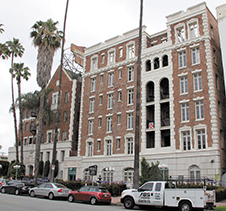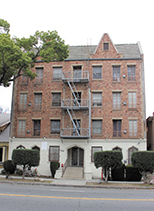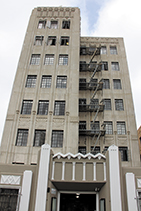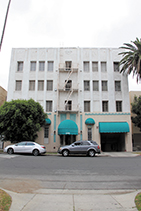‘Chateaux in the sky’ part 2: Gramercy, St. Andrews and Manhattan
‘The Places’ take center stage
It must have been quite a shocking sight in the late 1920s as a swell of development erupted in “The Places” along Gramercy, St. Andrews and Manhattan between Third Street and Olympic Boulevard. Like a giant monopoly board, multistory apartment buildings sprouted up amidst a flat landscape of vacant lots, bungalows and Craftsman mansions which were often moved away to make room for the new colossuses in their midst.
Stately tracts such as Westminster Square, Westminster Place, Western Wilshire Heights and Country Club Park, originally laid out for single-family use, transformed into multifamily districts. The proximity of “The Places” to the important intersection of Wilshire Boulevard and Western Avenue — with its multiple streetcar line connections, the cachet of Wilshire being promoted as the “Fifth Avenue of the West,” as well as the three blocks being a gateway to the leafy communities to the west — made “The Places” an ideal location for growth.

608-614 S. ST. ANDREWS PL., the Versailles Apartments, is a project designed circa 1928 by architects Henry L. Gogerty, Carl Jules Weyl and E.B. Rust.
Ada Bell Maescher, president of the De Luxe Building Company and one of the most successful women in the U.S. at the time, was the first to dip her toe into the market, building a 29-unit Renaissance Revival “tenement” in 1923 at 539 S. Manhattan Pl. Maescher was a real booster for Los Angeles, even going so far as to produce a film titled “Night Life in Hollywood” presenting a vision of a beautiful and exemplary city to contrast the louche reputation it commonly held. Within three years, other developers were following the prescient Ada Bell, and, by 1930, 26 more apartment buildings over four-stories tall were built along Gramercy, St. Andrews and Manhattan places.

712 S. WILTON PL. apartment building is known as the Tufford Arms.
The year 1926 was the beginning of the apartment gold rush with the construction of The Ancelle Apartments at 701 S. Gramercy Dr. and 3950 W. Eighth St. by William Allen, architect of the Art Deco Burbank City Hall and, later, the Alhambra City Hall. These somewhat austere examples gave way to more exuberant designs, such as the grand Astor Arms Apartments at 801 S. Gramercy Dr. by Henry L. Gogerty and Carl Jules Weyl and the P.W. Howles Building with its Churrigueresque details at 620 St. Andrews Pl. by Richard King. Gogerty was the designer of the Hollywood Playhouse (now the Avalon Club) on Vine Street and the Yucca Vine Tower, while Weyl was responsible for the Hollywood Brown Derby and the Gaylord Apartments on Wilshire. Weyl would later win an Oscar for Best Art Direction for the 1938 film “The Adventures of Robin Hood.” Richard King would go on to design the famed Villa Riviera in Long Beach, as well as the Art Deco Redwine Building in Hollywood.

535 S. GRAMERCY PL., La Marquise, shows off a 1929 Art Deco design by Paul Kingsbury.
Developers began to recruit architectural talent of the more theatrical variety such as Lewis A. Smith. A virtuoso of theater design whose work included The Tower Theater (with S. Charles Lee) and Vista Theater, among nearly 40 others, Smith won two local commissions: 939 S. Gramercy Pl. and 3707 San Marino St. For both, Smith employed the Renaissance Revival style, which became very popular among architects for such projects as it employed an endless variety of flexible and interchangeable elements for multiple designs. It projected an aura of history, class and panache to attract renters. The two apartment buildings were completed in 1927, along with the Arwyn Manor Apartments at 3835 W. Eighth St. (also Renaissance Revival) by C. W. Powers, and William Allen’s Chateauesque 715 S. St Andrews Pl.
On the eve of the Depression in 1928, building in the area ramped up significantly. Architects Gogerty and Weyl were joined by Los Altos Apartments architect E.B. Rust to design the magnificent Versailles Apartments at 608-614 S. St. Andrews Pl. Its dramatic Chateauesque design included French doors, a steeply pitched roof, arches and an ornamental garden. Also in 1928, Max Maltzman, of The Ravenswood and 410 N. Rossmore Ave., would design an everyman’s Elizabethan-style apartment building at 974 S. Gramercy Pl., a style that would be echoed by the Tufford Arms at 712 S. Wilton Pl. C.W. Powers produced an Art Deco-Renaissance Revival hybrid at the St. Andrews Manor at 516 S. St. Andrews Pl. The same street would also see the building of smaller Spanish Colonial Revival apartments, the Plaza Cordova at 729 S. St. Andrews Pl. and Casa Bella at 735 S. St Andrews Pl., most certainly inspired by the reemergence in popularity of the Ramona fable on the silver screen by Dolores del Rio.
By 1929, the party was at its height, with some of the most significant and playful designs. Art Deco began to assert its full influence with Paul Kingsbury’s stunning Art deco tower, La Marquise, at 535 S. Gramercy Pl., featuring a ceremonial gateway and sunburst appliqués. The designers Padelette Hollingsworth and C.H. Horner would also produce a Chateauesque-Art Deco hybrid at 634 S. Gramercy Pl. The ever-present C.W. Powers also designed an apartment block with Art Deco icing at 320 S. Manhattan Pl. Charles C. Frye, architect of the Palace Hotel in San Francisco, was recruited to build another chateau, the Gramercy Tower Apartments at 160 S. Gramercy Pl. The decadence continued with 621 S. Gramercy Pl., architect Louis Selden’s try at a French Renaissance rival to the Versailles around the block. Even Max Maltzman returned for a final bow with the Beaconsfield Apartments, a fussier version of his earlier Elizabethan at 329 S. Manhattan Pl.

320 S. MANHATTAN PL. is an apartment block designed with Art Deco influence by C.W. Powers.
The Great Depression would draw the curtain on the era of castles and chateaux in “The Places,” and the pre-war period would see only two apartment buildings of note and more than three stories tall. Although five years apart, both of those buildings would involve architect Milton J. Black, Los Angeles’ premier Streamline Moderne architect. His first work was in 1935 at 722 S. Manhattan Pl., a half-hearted chateau apartment building (sadly much altered). He later redeemed himself by building, in conjunction with H. Guthrie Thursby, the fabulous Richardson Apartments at 748 S. Gramercy Dr., second only in the larger Greater Wilshire to Black’s legendary Mauritania Apartments built on Rossmore in 1934.
The post-war era would see another boom of construction, this time in a more modern, egalitarian and futuristic style (perhaps to be explored in a future column), but gone were the days when developers and architects built in the manner of kings and designed as if, in the words of S. Charles Lee, “the show starts on the sidewalk.”
Category: Real Estate
